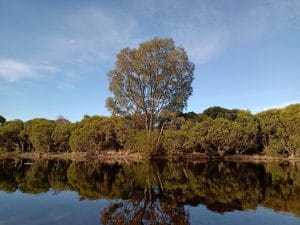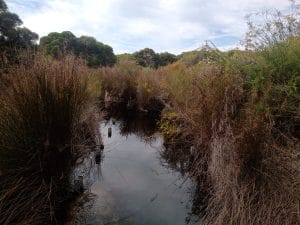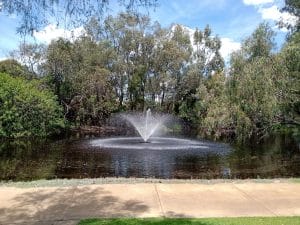In our screen-dominated world, it’s easy to forget the calming power of spending time in nature. Yet, stepping away from our devices, even briefly, can restore balance, reduce stress, and provide a much-needed reset.
As I hear and read of parents and others concerned about the ubiquitous nature of life spent on screens, I am reminded of a Michael Leunig cartoon I saw many years ago of a child looking at a beautiful sunset on their TV screen when beside them, the “real thing” can be seen outside the window.
I will admit, that I probably spend too much time in front of screens myself, primarily this laptop computer screen. However, one way I try to limit my time in this fashion is trying whenever I can, to get away from the screen, (at lunchtime at least) by going to a local park, as depicted on the front of my website, and sit by one of the ponds having my lunch. (It is also the location used a while ago by Luke Riley to shoot some promotional photos for me.)

I often “prescribe” to my clients the activity of “Spending time in nature.” I even provide a handout with instructions and a map to a local park just a few minutes’ drive from my office. One does not need to use this specific location; any park or natural area can serve the purpose. In the past, for example, on the HPCCH Facebook page, I’ve posted pictures of me going to Hyde Park after purchasing some books from Beaufort Street Books.
The Science Behind Nature’s Benefits
Julia Baird, in her book Phosphorescence – On awe, wonder & things that sustain you when the world goes dark, reminds us of the deep connection humans have with nature: “A love of nature is coiled within our bones, laced in our blood.” This profound insight helps explain why time spent in nature feels so restorative—it’s an intrinsic part of who we are.
Similarly, Dr. Kristy Goodwin’s Dear digital, we need to talk… : a guilt-free guide to taming your tech habits and thriving in a distracted world, tells the heartwarming yet poignant story of a young girl saving her pocket money to pay for an hour of her mother’s undivided attention—free from phones and other screens. It’s a reminder of the importance of being present, not just for ourselves but for those we care about.
For parents concerned about screen time, the American Psychological Association has published “Star Screen Time Tips” a helpful guide to motivate children to limit screen time to less than two hours daily.

Practical Tips for Spending More Time in Nature
Spending time in nature can be as simple as:
- Taking a walk in a nearby park.
- Listening to the birds and the wind in the trees.
- Bring your lunch outdoors to enjoy a change of scenery.

What can you do to ensure you spend time in nature? I often give clients a copy of my “Weekly Balanced Life Chart” and suggest they use it to schedule time doing things they enjoy. E.g. a regular Yoga class, and many other activities. (One side is suggestions, the other is for their own choices). I tell clients nothing is set in stone; it is a case of “On Tuesday I like to….” and so on. Remember that there are only 24 hours in a day. For those having trouble making decisions about what is important versus what is not the “Decision Matrix” also available from my website may be of use.
A Reflection on Priorities
When you reflect on your life, what will matter most? The hours spent scrolling through social media—or the moments of joy, calm, and connection found in nature? Prioritising time for yourself is an act of self-care, and stepping into nature can be the first step towards rediscovering balance and clarity.
Nature is always ready to welcome you—whether it’s a peaceful walk in the park, the soothing sight of a pond, or the calming melody of birdsong. Taking that first step away from the screen can be a small but powerful way to reconnect with yourself and the world around you. If you’re struggling with the challenges of taking time for yourself or need help clearing your mind, HPCCH is here to support you.




